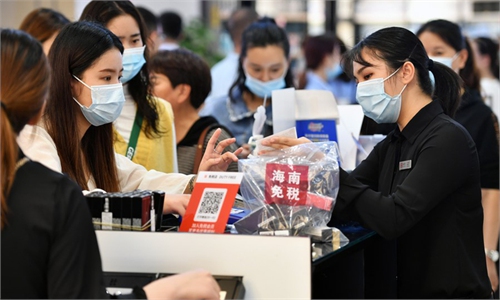China’s consumer market on track for rebound with wide-ranging support: official
Officials vow broad moves to boost consumption in 2022

Shanghai residents enjoy shopping spree ahead of Spring Festival Photo:Chen Xia/GT
China's consumer market is on track for restorative growth this year despite sporadic COVID-19 outbreaks, the Ministry of Commerce (MOFCOM) said on Tuesday, vowing wide-ranging moves to boost consumption, a vital pillar of the world's second-largest economy.In response to a question from the Global Times at a press conference in Beijing, Xu Xingfeng, an official with the MOFCOM's department of market operation and consumption promotion, said that China's consumer market would maintain restorative growth at large in 2022.
His outlook was based on China's normalized epidemic containment policies that are more targeted and scientific in the face of sporadic virus flare-ups, which stabilize consumer expectations.
Moreover, the country's middle-income population is constantly increasing, while residents' incomes are rising. In 2021, China's per capita GDP surpassed $12,000, while per capita disposable income jumped 9.1 percent year-on-year to 35,000 yuan ($5,531.76), laying the foundation for consumption, according to Xu.
Policies to boost domestic demand and consumption are gradually taking effect, underpinning a rebound in consumption, he said.
It's noteworthy that there's a consumption boom in China's winter sports industry as the Beijing Winter Olympics approaches, the MOFCOM official said, with skiing equipment sales doubling on some e-commerce platforms.
Winter Olympics-related consumption activities, including snow and ice experiences, are expected to be an economic silver lining amid the epidemic, according to Tian Yun, a Beijing-based economist.
The ministry also pledged new pro-consumption efforts, including moves to bolster car, home appliance, furniture and catering consumption; a ramped-up push for new types of consumption; innovation in time-honored brands, and advocacy for low-carbon consumption and imports of premium consumer items.
An upgrade in urban consumption, measures to address weak links in rural spending, and promotional activities, including the continuation of a month-long consumption-themed campaign, were also cited as moves in the pipeline to stabilize market expectations and revitalize consumer confidence.
Retail sales grew 12.5 percent last year to 44.1 trillion yuan. Final consumption expenditure contributed to 65.4 percent of China's economic growth, indicating that consumption once again was the top driver for growth, Guo Tingting, head of the MOFCOM's comprehensive department, told reporters on Tuesday.
The MOFCOM officials' remarks fed optimism in China's consumer market, which has taken a hit from the coronavirus.
Retail sales growth was caught in a downward spiral over the last few months of 2021, dipping to 1.7 percent in December from 34.2 percent in March, data from the National Bureau of Statistics showed.
The December slowdown was due to renewed virus concerns, Lian Ping, head of Zhixin Investment Research Institute, told the Global Times on Tuesday.
He cited multiple factors behind a relatively quick rebound in consumption throughout this year, however.
Retail sales are likely to grow more than 6 percent this year amid an overall economic moderation, Lian said, adding that the reading would rebound to pre-pandemic levels.
Mirroring an overall global downturn, China' s economy was forecast to record an 8 percent expansion in 2021 before moderating to 5.1 percent in 2022, according to the World Bank's most recent estimates earlier in January.
The Chinese economy faces three major challenges this year - demand contraction, supply shocks and weakening expectations, per the annual tone-setting Central Economic Work Conference in December.
Still, as Lian put it, growth in Chinese household incomes is estimated to hold up this year as the government aims to increase outlays through fiscal transfers to enable rising incomes.
Tax and fee cuts, an estimated rise in pensions and wages as well as increased subsidies for low-income people are considered among the areas supposedly championed by the government.
The country will scale up tax and fee cuts this year, Vice Finance Minister Xu Hong told a separate press conference, vowing an extension of the tax and fee cuts due to expire at the end of last year for small, micro-sized and individual businesses.
The central government will continue to ramp up transfer payments to local governments to ensure sufficient funding for local tax and fee reductions, Xu said.
With the manufacturing sector expected to remain resilient this year, as measured by production and investment, the job market would remain stable, Lian commented. But he said that the labor-intensive services sector will be subject to virus-related uncertainty.
In a research report sent to the Global Times, Xiong Yi, chief China economist at Deutsche Bank, said that the gap between household incomes and outlay increases began to gradually narrow in the second quarter of 2020 and was nearing a balance in the third quarter of 2021.
Household saving rates have also recovered to about 30 percent of pre-pandemic levels. Additionally, the urban employment rate has fallen below 5 percent, the first time since 2019, while migrant workers' average monthly incomes grew by 3.8 percent during the third quarter of 2021 from the quarter before, or yearly growth of 10.4 percent, an indication that the epidemic hasn't had a major negative impact on the labor market, according to Xiong.



